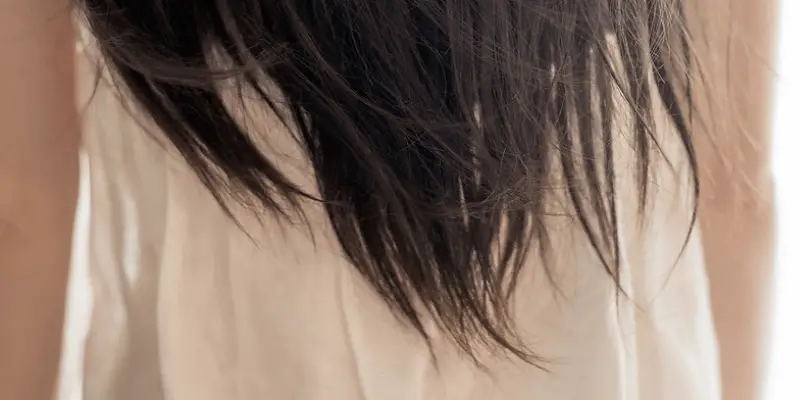What is Bamboo Hair?
Bamboo hair is an abnormal medical condition where the hair shaft is split and leaves a very sharp, stiff, needle-like tip. This condition may be present from birth (congenital), or it may develop later in life (acquired).
Bamboo hair is also called trichorrhexis invaginata, and it is a type of epidermal inclusion cyst. It is not a true hair shaft deformity, as it does not involve the formation of a hard keratin core.
Rather, it is thought that this phenomenon occurs as a result of chemical changes in the hair shaft during its aging process which cause the shaft to swell and twist on itself, causing one or more sharp points at its end.
Bamboo hair is usually found at the ends of the hairs. It is frequently seen in children and young adults, though it may also appear later in life. In adults, bamboo hair usually occurs on only one side of the scalp.
This condition can be present in other parts of the body as well, but it is most commonly found on the scalp or beard area.
Symptoms of Bamboo Hair
The symptoms of bamboo hair include:
1. Hair That Breaks Easily
The most common symptom of bamboo hair is a broken strand. A person may notice one or more hairs that have a split, pointed tip. If the bamboo hair becomes separated from its follicle, it can cause inflammation and form a pustule under the skin.
2. Hair That Has a Knotty Appearance
Bamboo hairs often have a knotty appearance, with a very sharp point at its tip. Bamboo hair may also have an irregularly-shaped cross-section.
3. Loss of Eyelashes or Eyebrows
A deficiency in the eyebrows is sometimes associated with bamboo hair. This is generally accompanied by a loss of eyelashes.
4. Loss of Hair in the Scalp Region
Some people may notice that their hair is thinning or becoming more scarce in the scalp region.
Bamboo hair can be present at birth, and it may represent an abnormality that runs in families. It usually appears on one side of the scalp.
5. Sparse Hair Growth or Hair Loss Pattern
Bamboo hair is often accompanied by abnormal patterns of growth and loss of hair around its base. The presence of bamboo hairs can make existing hair more brittle and prone to breakage.
6. Dry Hair
Bamboo hair can be associated with dry hair or hair that lacks luster and shine. This may be related to the sharpness of the split tip. Hair is moistened by the sebaceous glands, and a sharp tip can make the hair dry out more easily.
The split also prevents the gland from secreting its natural oils into this region of the shaft. But when a person has bamboo hair, the lack of moisture is not caused by a problem with the sebaceous glands. In this case, there is no defect in the secretion process.
Rather, it’s due to the sharp split tip that prevents natural oil from reaching this section of the strand.
7. Unusually Spiky Hair
In some cases, a person may notice that their hair is very spiky. This condition can be quite noticeable in young children who have not yet developed a full head of hair.
The sharpness of the bamboo hair tip can cause spikes to form when the strand dries after it has been washed. Bamboo hairs are common among infants, particularly those that are born prematurely.
What Causes Bamboo Hair?
Bamboo hair is generally considered to be a genetic condition. Studies have revealed that the bamboo hair symptom is associated with an autosomal dominant transmission pattern. This means that if one of your parents has bamboo hair, you are more likely to have it as well.
A mutated gene called SPINK5 is thought to be a major factor in bamboo hair. Mutations in SPINK5 can cause abnormal hair growth. In some cases, the gene is mutated in the very early stages of embryonic development so that a person’s hair follicles lack one of the proteins needed for healthy strand formation.
How to Treat Bamboo Hair
The following treatments may be effective for bamboo hair:
1. Hair Conditioners and Moisturizers
If your bamboo hair becomes dry, you can use a moisturizing conditioner to reduce the spikiness of the strand tip. When choosing a conditioner, make sure that it is free of sulfates and parabens. Both of these chemicals may be drying to the hair shaft.
2. Medicated Shampoo
In some cases, a person may discover that their bamboo hair is caused by an overgrowth of yeast on the scalp. In this case, medicated shampoo can help reduce the amount of fungus growing in your pores. Look for a medicated shampoo that contains zinc pyrithione or ketoconazole to fight fungal growth.
3. Styling Products
Bamboo hair can also become spiky when it dries and is exposed to the air. A blow dryer and/or a flat iron will make your bamboo hairs less spikey. You may want to avoid using these products if you have fine or thin hair, however, since they can make these types of strands even more fragile.
4. Hair Transplant
If your bamboo hair is accompanied by patchy or bald regions, then you may want to consider undergoing a surgical scalp transplant procedure. This process involves surgically implanting healthy donor hairs in the bald region of the scalp. A doctor will recommend this treatment if other methods fail to produce satisfactory results.
Summary
Bamboo hair is a genetic condition that can cause breakage of the shaft, dryness, lack of luster and shine, spikiness, or even patchy bald regions.
These symptoms are usually not caused by an underlying health issue but rather from the sharp bamboo tip on your strand that prevents moisture from reaching this section of the hair.
For best results in treating bamboo hair, look for products free of sulfates and parabens as these chemicals may be drying to the strand.
Medicated shampoos with zinc pyrithione or ketoconazole may also help reduce fungal overgrowth on your scalp which could lead to more brittle strands.
Surgery such as a scalp transplant procedure might prove effective if other treatments have been unsuccessful at reducing bamboo hair symptoms.
Bamboo Group is a collaboration of individuals who love the world’s most sustainable and eco-friendly natural material. We believe every home can benefit from the natural colors and patterns of bamboo. We’re excited to see bamboo grow in popularity and get the recognition it deserves. Years of experience growing bamboo plants have taught us a lot we want to share with the world.



